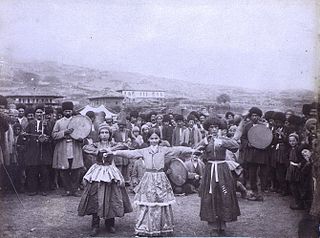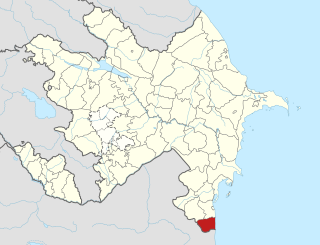
The Talysh people are an Iranian ethnic group, with the majority residing in Azerbaijan and a minority in Iran. They are the indigenous people of the Talish (Talyshstan), a region on the western shore of the Caspian Sea shared between Azerbaijan and Iran. The main city of the Talysh people and their homeland is Lankaran, the majority of the population of which is ethnically Talysh. They speak the Talysh language, one of the Northwestern Iranian languages. The majority of Talyshis are Shiite Muslims.

Lerik District is one of the 66 districts of Azerbaijan. It is located in the south-east of the country and belongs to the Lankaran-Astara Economic Region. The district borders the districts of Yardimli, Masally, Lankaran, Astara and the Ardabil Province of Iran. Its capital and largest city is Lerik. As of 2022, the district had a population of 87,000. It is located between the Talysh Mountains and the agricultural plain of the Lankaran Lowland.

Astara District is one of the 66 districts of Azerbaijan. It is located in the south-east of the country and belongs to the Lankaran-Astara Economic Region. The district borders the districts of Lankaran and Lerik, as well as the Ardabil and Gilan provinces of Iran. Its capital and largest city is Astara. As of 2020, the district had a population of 110,000.

Lankaran District is one of the 66 districts of Azerbaijan. It is located in the south-east of the country and belongs to the Lankaran-Astara Economic Region. The district borders the districts of Astara, Lerik, Masally, and Neftchala. Its capital and largest city is Lankaran, although the city is technically not part of the district and is subordinate to the Republic. As of 2022, the district had a population of 232,000.

Lankaran is a city in Azerbaijan, on the coast of the Caspian Sea, near the southern border with Iran. As of 2021, the city had a population of 89,300. It is next to, but independent of, Lankaran District. The city forms a distinct first-order division of Azerbaijan. The city is mostly populated by the Talysh people, and serves as the main urban centre of this people and its ethnic homeland, Talyshstan.

Talysh is a Northwestern Iranian language spoken in the northern regions of the Iranian provinces of Gilan and Ardabil and the southern regions of the Republic of Azerbaijan by around 500,000-800,000 people. Talysh language is closely related to the Tati language. It includes many dialects usually divided into three main clusters: Northern, Central (Iran) and Southern (Iran). Talysh is partially, but not fully, intelligible with Persian. Talysh is classified as "vulnerable" by UNESCO's Atlas of the World's Languages in Danger.

Talysh Khanate or Talish Khanate was an Iranian khanate of Iranian origin that was established in Afsharid Persia and existed from the middle of the 18th century till the beginning of the 19th century, located in the south-west coast of the Caspian Sea.

Lahıc is a village and municipality on the southern slopes of Greater Caucasus within the Ismailli Rayon of Azerbaijan. Population is approximately 860 people who speak the Tat language, also known as Tati Persian, a Southwestern Iranian language spoken by the Tats of Azerbaijan and Russia.

This article focuses on ethnic minorities in the Republic of Azerbaijan.

The khanates of the Caucasus, also known as the Azerbaijani khanates, Persian khanates, or Iranian khanates, were various administrative units in the South Caucasus governed by a hereditary or appointed ruler under the official rule of Iran. The title of the ruler was khan, which was identical to the Ottoman rank of pasha. Following the assassination of Nader Shah in 1747, internal chaos erupted in Iran, particularly in the South Caucasus, where semi-autonomous khanates emerged as a result of the lack of a centralized government. The khans neither had territorial or religious unity, nor an ethnic/national identity. They were mostly interested in preserving their positions and income.

The nagara or naghara is a drum used in India. There are several types of naghara, which is considered to be the lead instrument in mandir ceremonies and weddings. These are typically two drums, one treble and one bass and are played with sticks.

The Uganda Museum is located in Kampala, Uganda. It displays and exhibits ethnological, natural-historical and traditional life collections of Uganda's cultural heritage. It was founded in 1908, after Governor George Wilson called for "all articles of interest" on Uganda to be procured. Among the collections in the Uganda Museum are playable musical instruments, hunting equipment, weaponry, archaeology and entomology.

Russians in Azerbaijan are the second largest ethnic minority in Azerbaijan and is also the largest Russian community in the South Caucasus and one of the largest outside of Russia. Although in decline, the community still numbers 71,000 people as of 2019. Since their arrival at the beginning of the 19th century, the Russians have played an important role in all spheres of life, particularly during the Czarist and Soviet period, especially in the capital city of Baku.
Fatali Khan or Fath Ali Khan of Quba was a khan of the Quba Khanate (1758–1789) who also managed to dominate the Derbent, Baku, Talysh and Shirvan Khanates, as well as the Salyan Sultanate during much of his reign.

The Qoltuq nagara of Azarbaijan (Armpit drum) is a folk drum with double head that is played on one side with the bare hands. It is used in Uzbekistan, Turkey, Iranian Azerbaijanis, Azerbaijan, Qazaqstan, Qafqaz, Kirghizistan, armenian Georgia and other Caucasus regions. It has different names, according to the territory in which it is played. This membranophone is different from the dhol and nagara of India.
Tālīsh is a historical and geographical region near the southwestern coast of the Caspian Sea, an area of compact residence of the Talysh people. It got its name from the ethnonym of the Talysh people inhabiting it.

The Lenkoran uezd or Talysh uezd was a county (uezd) within the Baku Governorate of the Russian Empire, and then of the Azerbaijan Democratic Republic and the Azerbaijan SSR until its formal abolishment in 1929. The county was located on the southern part of the governorate, bordering Caspian sea to the east, Javad uezd to the north, and Iran to the southwest. The administrative centre of the county was the city of Lenkoran.

Mirsalaev Boyukagha was a Talysh public and political figure and second secretary of the Transcaucasian Communist Party.
















